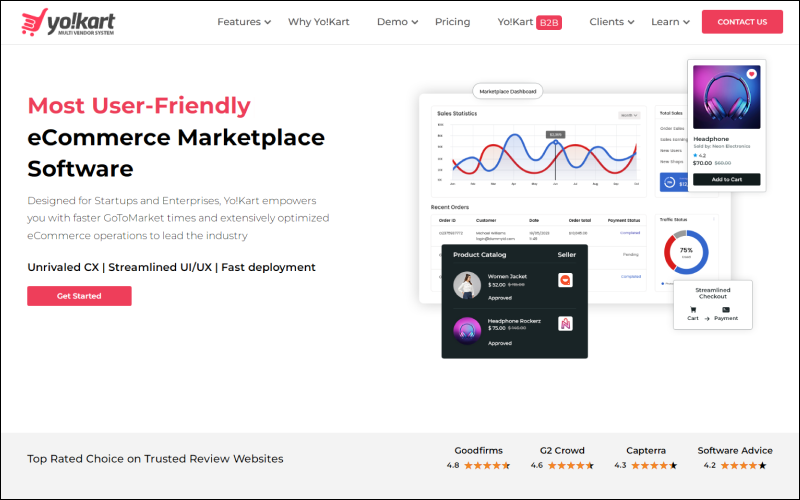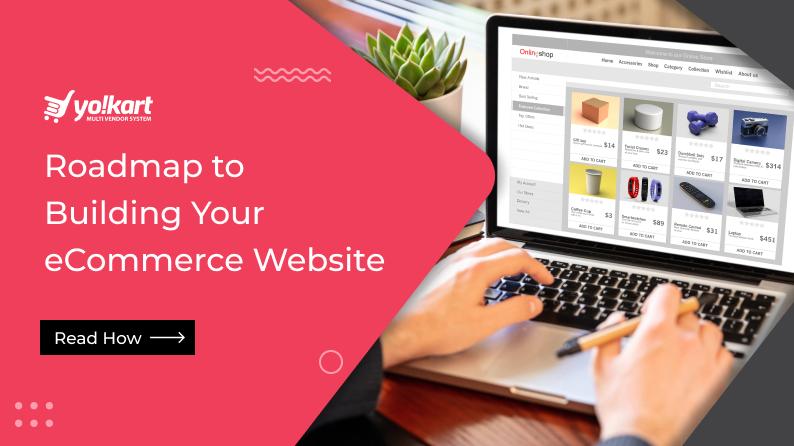eCommerce has come a long way since its early days. From being a new concept to an enforcer of seismic shifts in commerce paradigms to an imperative for an even more digital-driven future.
Picture this: For every need, consumers need to rush to the nearest brick-and-mortar store including access to popular brands. It seems like a long time ago, doesn’t it? Consumers today turn to the internet for various needs – products, digital media, services, daily essentials, on-demand food delivery, et al.
The reasons for this rise of eCommerce are beyond just the convenience it offers to the users – a fundamental driver of this shift is the continued technological progression. Think, how each time any eCommerce app on your device announces an update, there is a level up in the user experience. Likewise, these advancements have also been happening in the entire support infrastructure. The good news is that this has not been eCommerce’s 15 seconds of fame. As the sector becomes increasingly intertwined with consumers’ lives, the future is expected to bring even more exciting opportunities for businesses.
In this blog, read the key information that will help you get going with your own eCommerce business – learn how to build an eCommerce website in 2024. Spoiler alert: It is easier than you think!
Table Of Contents
Decoding Nuances in eCommerce Websites
From Amazon to Alibaba, to an upcoming eCommerce website like Podia – eCommerce websites seem to be similar from the outset. To an extent this is true, but if you explore the nuances – each of these popular players offers tailored experiences to its target users. To understand this a little more, let’s first see which are the types of eCommerce websites.
Variations Based on Vendor Role and Participation
Multi Vendor website (eCommerce marketplace): The type of eCommerce website we are more familiar with as consumers. A multi vendor website is like Amazon, where multiple vendors are selling to buyers. The website is operated/owned by the intermediary party.
Single vendor website (Online Store): eCommerce websites owned/operated by a brand/seller, which sells its inventory. For instance Apple’s website.
Variations in eCommerce Websites Based on What is Offered:
- Physical Products: Websites like Walmart, that offer tangible products
- Services: Websites like Airbnb or Fiverr, offer just services.
- Digital Products: Kindle, Spotify, and even Netflix are eCommerce websites with digital products.
Build an e-commerce Website of your Preferred Medium
Differences in eCommerce Websites Based on Operative Business Model:
- B2C: Take Amazon’s example, sellers sell to end consumers.
- B2B: For instance, Amazon business where businesses sell to other businesses.
- C2C: eBay or Etsy where users can be sellers, consumers, or both.
Variations Based on Geographical Area Served:
- Global marketplaces: eCommerce websites like Alibaba, Amazon, or Lazada that operate across borders.
- Hyperlocal marketplaces: Websites which deliver within a localized geographical area like Instacart.
While these are some of the broad classifications for eCommerce websites, there can be more specificities depending on the operations of the business. For instance, some C2C websites may involve renting options as well. A popular example is Rent the Runaway. So the eCommerce website in such a scenario will be different to other C2C websites, to cater specifically to this niche.
Plan before you Leap – Consider Prudent Funds Allocation
When compared to a brick-and-mortar business, the costs to own and run an eCommerce business is less. Still, there are many dynamics at play. An eCommerce business will need you to allocate available resources between multiple dependencies. Hence it is important that you first create a business plan. Based on the same, you can draft a financial strategy.
Once you have a precise understanding of financial dependencies, you can allocate resources more prudently towards developing your eCommerce website.
Let’s run through some of the many facets of an eCommerce business, that will need resource investment.
- Market research costs.
- eCommerce website development costs.
- Payment Gateway setup charges.
- Marketing, advertising, and promotional activities.
- Implementing Security Measures.
- Legal and Compliance.
- Infrastructure costs and setting up a team.
- Setting up and providing customer support.
If you look closely, each of these is equally important. Moreover, depending on your business idea, the finances required for each of these can be tailored to a specific amount. For instance, you can pour thousands of dollars into the development of your platform, but you are left with a limited purse for marketing. An eCommerce platform is useless if the target users are oblivious to its existence. Likewise, if you have a platform that cannot meet the users’ needs, all other efforts can go in vain. Hence the importance of prudent budgeting – you need to approach each stage with balanced precision.
Simplify Finances with an Affordable Solution
Let’s get to it – Build your eCommerce Website
There are two ways by which you can approach the development of your eCommerce website. Let’s understand what are these and which one is right for you.
Develop from scratch
Building the website from scratch would mean setting up the code right from the start. You can either avail services of an eCommerce development company or hire a team for the purpose. This whole process can take a few months to complete. The resources required will vary depending on the complexity of your eCommerce website. For most business needs, an eCommerce website can be built anywhere between $10,000 to $50,000.
Using a Turnkey solution instead
If you have noticed in the section above, clear distinctions about the type of eCommerce websites can be made. Most website development requirements tend to fall under this broad spectrum of eCommerce website types. Hence building an eCommerce website from the ground up, for each new eCommerce website may not be required. There are turnkey solutions available, that can allow you to set up an eCommerce website, with minimal effort. Depending upon your choice of solution, and your needs, you can get started at a fraction of the development costs. Furthermore, the time required is also comparatively less than developing the entire website from scratch.
Considering the lower costs and time required, the second option is the more popular choice for most eCommerce requirements. And this holds for SMBs and larger businesses alike. The first choice is opted by businesses in the rare scenario of unique eCommerce concepts, that can’t be built using turnkey solutions. Moreover, enterprises considering leveraging their existing legacy systems may also consider the former approach. For everything else, turnkey solutions are the preferred choice. Let’s see which are the leading turnkey solutions to build an eCommerce website.
Top 5 eCommerce Website Builders – Unique & Popular
eCommerce website builders are not a new concept. As a matter of fact, these solutions can roughly trace their origins to the popular browser Netscape. With the implementation of Secure Sockets Layer (SSL) encryption for secure transactions, the browser released the CommerceXpert suite in the 1990s!
Over some time, these have evolved as much as eCommerce itself. These vary greatly amongst themselves on several parameters, and businesses can choose as per their requirements and intended use case. For instance, there is a significant difference between B2B and B2C eCommerce websites. So depending upon the business model, entrepreneurs can opt for B2C or B2B solutions with purpose-built features.
Discussed below are the top 5 eCommerce website solutions, each leading the industry for a specific purpose/use case.
YoKart – Best Multi vendor eCommerce Website Builder

YoKart is a leading solution for building a multivendor eCommerce website like Amazon or eBay. It is a self-hosted solution, which means your eCommerce website will be hosted on a server of your choice. Moreover, to give you more freedom, YoKart is available with the source code – with the one-time payment options i.e. there are no recurring charges.
The eCommerce solution has powered more than 5000 eCommerce websites globally. One of the main reasons behind YoKart’s popularity is the range of eCommerce features it offers. This makes it compatible with a wide range of business models including B2C, C2C, and more.
Furthermore, considering that B2B eCommerce entails specific complexities, there is a dedicated solution YoKart B2B that allows building a B2B-specific eCommerce website like Alibaba.
Both YoKart and YoKart B2B also come pre-integrated with popular payment gateways and business APIs. So with these readymade solutions getting started with your eCommerce website is quick and easy. In case you have unique requirements, for example building a marketplace like StockX – the in-house team offers customization services as well.
Pay Once – Own Forever
Shopify – eCommerce Store Builder
If your requirements are selling inventory from an online storefront, then you need to build an eCommerce store. Shopify is a robust and popular choice to launch an eCommerce website (Online Store) that has just you as the seller. It is a SaaS solution, which implies that it is already hosted, and just requires you to sign up.
Pricing for Shopify is available in incremental packages. This means that the charges increase as your requirement for features increases. Also, these charges are recurring, and remain till the time you use the solution.
That said, Shopify comes with multiple features for an online store builder. If it meets your requirements, it is an easy choice to get started with.
Magento – Open Source eCommerce Solution
Magento, which is now known as Adobe Commerce, is an open-source eCommerce website builder. Open-source means that it is free to use and can be downloaded by anyone.
But unlike some of the other solutions like YoKart, Magento is not a completely readymade eCommerce website builder. It will need customizations to make it into a fully functional eCommerce website. For that purpose, it presents a very robust alternative. So while, the eventual website will be a bespoke platform, it will still undercut the “building from the ground-up” process.
Nonetheless, Magento development can require several man-hours, which implies that overall development costs will be higher and generally out of scope for smaller businesses.
Sharetribe – SaaS Solution for C2C Rental Websites
Just like Shopify, Sharetribe is a SaaS eCommerce website builder. However, unlike Shopify, the latter builds multi vendor platforms. Significantly though, Sharetribe allows you to build an eCommerce website that rents out products as well. Since the rental domain in eCommerce has its own complexities, very much like B2B. Hence, rental websites require a domain-specific set of features. Sharetribe offers these to the users.
However, unlike YoKart, Sharetribe also adopts an incremental approach to features, number of users, and transactions.Thus, the website restrictions will depend upon the price package chosen by the business.
Empower users with segment-leading Features
OroCommerce – Solution for B2B Online Stores
Orocommerce is another unique eCommerce solution. It is made for businesses considering to launch a B2B eCommerce store. While solutions like YoKart B2B can build an eCommerce B2B multivendor marketplace, Orocommerce can be used to build a B2B online store.
Moreover, some businesses may already be using some legacy systems in their organization. It may not be viable for them to update all of that with the introduction of an eCommerce policy. In such scenarios, the business will need integration of the eCommerce website with its legacy systems. Orocommerce can accommodate such scenarios.
While these were the top choices in the industry in their own right. You can explore a more detailed analysis of the top 16 multi vendor solutions – and choose the best solution as per your needs.
Wrapping Up – Launch your Dream Project with ease
Just like most startup ventures, an eCommerce business will also demand your complete attention on many fronts. It’s not just the finances that need prudent planning – time is of the essence as well. That is why turnkey eCommerce website builders have been since, well, the very beginning of eCommerce as an industry.
But more importantly, the more popular of these solutions have evolved with time to give eCommerce startups what they want most – an easy, purpose-driven start in a complex and competitive space.
So while the exciting journey of eCommerce entrepreneurship will get you thinking, planning and executing in several areas, at least one thing can be easily sought after – building an eCommerce website with readymade solutions.



